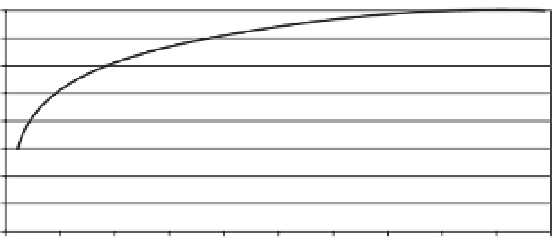Agriculture Reference
In-Depth Information
Influence of seeding rate on fibre content
percentage is more a function of seeding rate
than of variety.
Fibre content increased rapidly with increasing
density at emergence, as long as this was less
than 200 plants/m
2
(corresponding to a seed-
ing rate of 45-50 kg/ha, Fig. 5.9). At this den-
sity, fibre production achieved 90% of potential
(fibre content approximately 35%). Above a
density of 200 seedlings/m
2
, fibre content
continued to rise with increasing density but
very slowly (1-5% increase). However, since
fibre content of the stalk varies very little from
one variety to another, the increase of a few
percentage points is not insignificant; fibre
Influence of seeding rate
on hemp seed yields
The best hemp seed yields are obtained at a
low seeding rate. When the seeding rate is
very low, however (i.e. <20 kg/ha), hemp is
unable to smother weeds and yields tend to
stagnate.
Given that hurd yields are essentially inde-
pendent of a seeding rate above 20 kg/ha, farm-
ers may favour a reduction in the seeding rate.
100
95
90
85
80
75
70
65
60
0
10
20
30 40 50
Density of sowing (kg/ha)
60
70
80
90
100
seed yield
Hurd yield
Fig. 5.8.
The relative hurd and seed yields as a function of the density of sowing (expressed as kg/ha).
This is a synthesis of the tests undertaken by ITC (2003) (SPC, FNPC) and FNPC (1975, 1976, 1977,
2000, 2001, 2002) and FDGEDA de l'Aube (1982, 1989).
100
90
80
70
60
50
40
30
20
10
0
0
50
100 150 200 250
Density at emergence (p/m
2
)
300
350
100
Hurd yield
Fibre content
Fig. 5.9.
Hurd yields and relative fibre content as a function of seeding rate expressed as plants at
emergence/m
2
. The hurd yield results are a synthesis of the tests undertaken by ITC (2003) (SPC,
FNPC) and FNPC (1975, 1976, 1977, 2000, 2001, 2002) and FDGEDA de l'Aube (1982, 1989). Relative
fibre content results are a synthesis of the tests undertaken by the FDGEDA de l'Aube (1989).










































